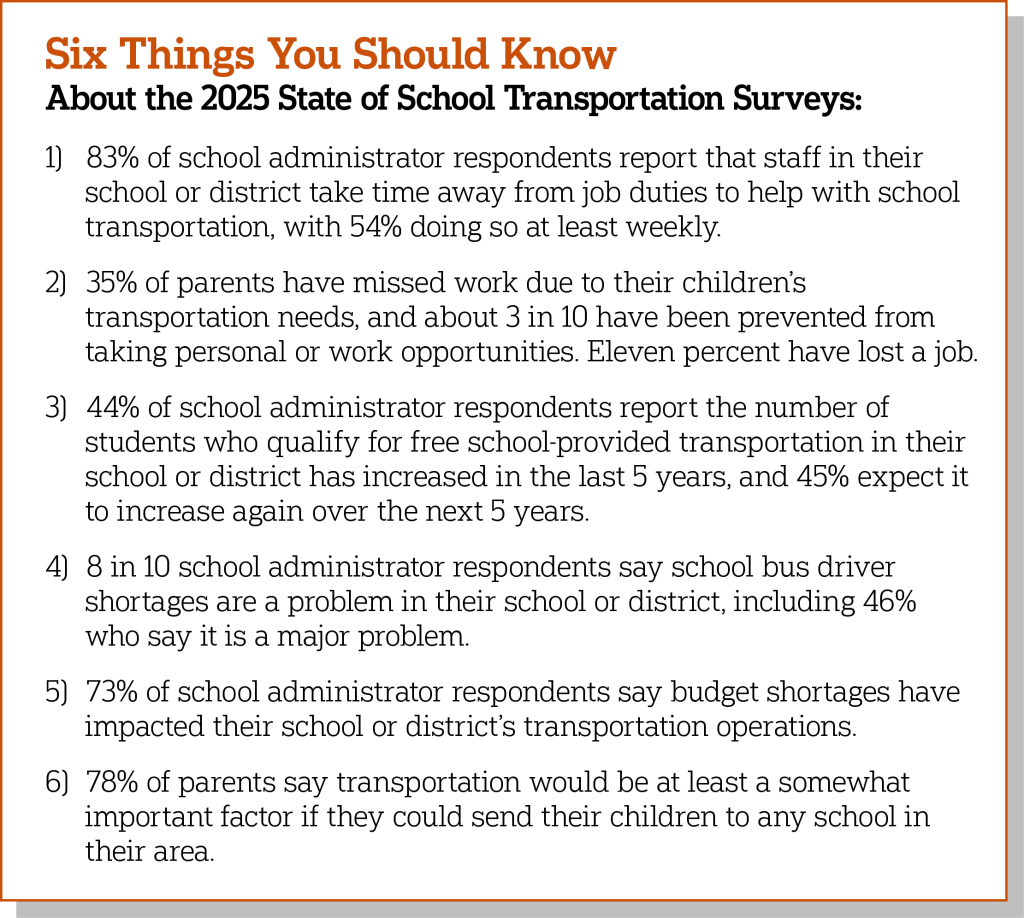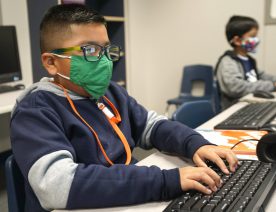
September 4, 2025
As students return to schools across the country this fall, a new pair of surveys conducted by The Associated Press-NORC Center for Public Affairs Research in partnership with HopSkipDrive, examines the current experiences of school administrators and parents when it comes to student transportation. In the context of increased nationwide bus driver shortages and shifting transportation needs and responsibilities, this study reveals the common experiences and problems that school administrators and parents face, and highlights potential solutions to these issues that both groups identify.
Both school administrators and parents express significant – and growing – challenges with student transportation. The surveys show many school administrator respondents face an increased demand for transportation services while grappling with constrained resources and labor shortages. Responses from parents of K-12 children show the impact of these transportation challenges, with many parents noting the connection between transportation and academic outcomes for their children. Students are missing out on educational opportunities or facing tardiness and absenteeism due to transportation challenges. Many parents, especially mothers, have suffered personal and professional impacts due to their children’s school transportation needs. And nearly all school administrator respondents report teachers and staff have to take time away from their core duties to cover transportation needs.
Nine in 10 school administrator respondents say the number of students who qualify for free, school-provided transportation is either growing (44%) or has stayed the same (46%) in the last 5 years, and 45% expect the need to keep increasing over the next 5 years.
As need increases, however, transportation operations of the schools or districts of school administrator respondents are struggling to keep up. Most have been impacted by bus driver shortages (80%) or budget shortages (73%). And most respondents say transportation access impacts many of the key issues their school or district faced in the last year, such as chronic absenteeism or tardiness.
Looking at the bus driver shortages, 81% of the school administrator respondents say school bus driver shortages are a problem in their school or district, including 46% who say it is a major problem. A quarter (26%) of respondents report that their school or district has addressed these shortages by cutting or shortening bus routes.
Furthermore, 83% of school administrator respondents say staff in their school or district have taken time away from their core job duties at least a few times a year to help with school transportation, such as managing school car lines or driving school buses or vans. Fifty-four percent do so weekly.
As schools struggle to keep up with transportation needs, student transportation is largely reliant on families driving. Ninety-one percent of school administrator respondents say at least some of their students are eligible for free, school-provided transportation, but 89% of students in their school or district are driven to school, and 78% of parents of K12 students say their children are typically driven in some way. Both parents (70%) and school administrator respondents (81%) agree that traffic congestion during pick up and drop off times is a problem.
Forty-three percent of parents say the school bus is part of their children’s typical school commutes, in addition to being driven. Among those who don’t typically ride the bus, 32% of parents say it’s because it’s not available in their area and 20% say it’s easier to get to school some other way.
Most parents experience some stress about their children’s transportation to school. Fifty-six percent of parents report feeling stressed about their children’s transportation at least a few times a year, with a quarter who are stressed at least monthly. About 3 in 10 have missed work (35%), been prevented from taking personal opportunities (31%) or work opportunities (28%), and 11% have lost a job due to needing to take their children to and from school or other activities. Women are significantly more likely than men to report being prevented from pursuing work opportunities (33% vs. 23%) or personal opportunities (37% vs. 23%) because of child transportation responsibilities. And 20% of women without a college degree report having lost a job due to transportation responsibilities, more than college educated women (2%).
Many parents also identify missed opportunities for their children because of issues with transportation, including 26% whose child has missed extracurricular activities in the last school year, 21% whose child has missed school services like school meals or counseling, and 17% whose child has missed tutoring or academic help. Forty-four percent report that their child has been late to school at least a few times in the last year due to issues with transportation.
If easier transportation options were available, about half of parents would be at least somewhat likely to sign their children up for more extracurricular activities (53%) or school services (48%). And 78% say transportation would be at least a somewhat important consideration if they could send their children to any school in their area.
There are areas of common ground between parents and school administrator respondents regarding potential solutions for the transportation issues they are facing. Among school administrator respondents, a majority favor organizing centralized pick-up and drop-off locations for students using school buses (73%), improving pedestrian and bicycle infrastructure in areas near schools (70%), and allowing school or districts to use school-arranged supplemental school transportation services such as cars and vans (65%).
About 4 in 10 parents agree that offering school-arranged supplemental transportation services, such as cars or vans, and improving pedestrian and bike infrastructure would make getting to school easier for their family, and a third say the same about organizing centralized pick-up and drop-off locations for students. About half say it wouldn’t make much difference to them.
The report provides a deep dive into school administrator and parent experiences with school transportation, the widespread impacts of transportation challenges, and attitudes toward potential solutions to improve school transportation across the country.

This study was conducted by The Associated Press-NORC Center for Public Affairs Research in partnership with HopSkipDrive.
The Parent Survey was conducted June 30 – July 11, 2025 using the AmeriSpeak Panel®, which is NORC’s probability-based panel designed to be representative of the U.S. household population. Online interviews were conducted with 838 adults with school-aged children (children age 5-17). The overall margin of sampling error is +/- 4.6 percentage points.
The School Administrator Survey was conducted June 30 – July 25, 2025, using sample sourced from a non-probability list from marketing data from a marketing database and from Dynata’s non-probability panel. Online interviews were conducted with 510 school administrators. Because non-probability panels do not start with a frame where there is known probability of selection, standard measures of sampling cannot be calculated for this sample.
- Suggested Citation: AP-NORC Center for Public Affairs Research. “2025 State of School Transportation Report” (September 2025). https://apnorc.org/projects/2025-state-of-school-transportation/





